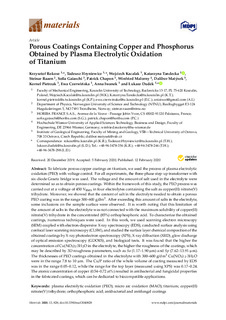| dc.description.abstract | To fabricate porous copper coatings on titanium, we used the process of plasma electrolyticoxidation (PEO) with voltage control. For all experiments, the three-phase step-up transformer withsix-diode Graetz bridge was used. The voltage and the amount of salt used in the electrolyte weredetermined so as to obtain porous coatings. Within the framework of this study, the PEO process wascarried out at a voltage of 450 VRMSin four electrolytes containing the salt as copper(II) nitrate(V)trihydrate. Moreover, we showed that the content of salt in the electrolyte needed to obtain a porousPEO coating was in the range 300–600 g/dm3. After exceeding this amount of salts in the electrolyte,some inclusions on the sample surface were observed. It is worth noting that this limitation ofthe amount of salts in the electrolyte was not connected with the maximum solubility of copper(II)nitrate(V) trihydrate in the concentrated (85%) orthophosphoric acid. To characterize the obtainedcoatings, numerous techniques were used. In this work, we used scanning electron microscopy(SEM) coupled with electron-dispersive X-ray spectroscopy (EDS), conducted surface analysis usingconfocal laser scanning microscopy (CLSM), and studied the surface layer chemical composition of theobtained coatings by X-ray photoelectron spectroscopy (XPS), X-ray diffraction (XRD), glow dischargeof optical emission spectroscopy (GDOES), and biological tests. It was found that the higher theconcentration of Cu(NO3)2·3H2O in the electrolyte, the higher the roughness of the coatings, whichmay be described by 3D roughness parameters, such asSa(1.17–1.90μm) andSp(7.62–13.91μm).The thicknesses of PEO coatings obtained in the electrolyte with 300–600 g/dm3Cu(NO3)2·3H2Owere in the range 7.8 to 10μm. The Cu/P ratio of the whole volume of coating measured by EDSwas in the range 0.05–0.12, while the range for the top layer (measured using XPS) was 0.17–0.24.The atomic concentration of copper (0.54–0.72 at%) resulted in antibacterial and fungicidal propertiesin the fabricated coatings, which can be dedicated to biocompatible applications. | nb_NO |

